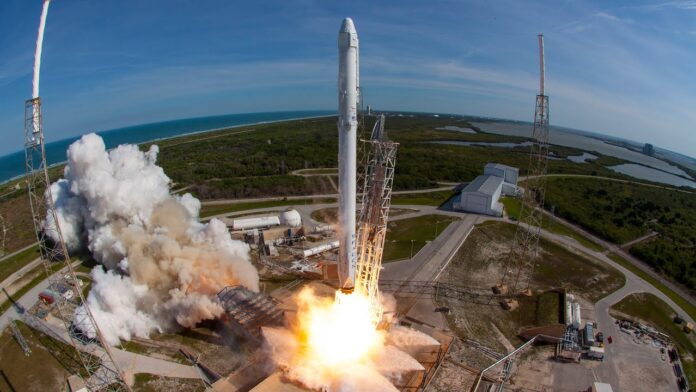A SpaceX Falcon 9 booster tips over and bursts into flames during its 23rd mission, ending a run of over 200 successful landings
SpaceX faced a setback as one of its Falcon 9 rocket boosters caught fire and toppled over after landing on the droneship A Shortfall of Gravitas. This incident marks the end of a remarkable streak of over 200 successful landings for the commercial space company. The booster in question had just completed its 23rd launch.
The booster was intended to land on the droneship stationed off the US East Coast, where SpaceX typically reuses its boosters to cut down the costs of space travel. Despite the booster’s failure to land upright, SpaceX confirmed that the main rocket successfully launched and deployed its payload of Starlink satellites.
SpaceX’s official statement highlighted the success of the ascent but acknowledged the issue with the landing: “After a successful ascent, Falcon 9’s first stage booster tipped over following touchdown on the A Shortfall of Gravitas droneship. Teams are assessing the booster’s flight data and status. This was the booster’s 23rd launch.”
The dramatic footage of the incident, showing the booster engulfed in flames, quickly circulated online. The mishap comes amid a series of challenges for SpaceX, including a delay of its historic Polaris Dawn mission, which was set to include the first-ever spacewalk by non-government astronauts. The mission has faced multiple delays due to technical issues and unfavorable weather conditions.
The Polaris Dawn mission, which was originally scheduled for launch from the Kennedy Space Centre in Florida, has been postponed further. SpaceX attributed the delay to a helium leak and adverse weather forecasts affecting the splashdown areas off the Florida coast. “Due to unfavourable weather forecasted in Dragon’s splashdown areas off the coast of Florida, we are now standing down from tonight and tomorrow’s Falcon 9 launch opportunities of Polaris Dawn. Teams will continue to monitor weather for favourable launch and return conditions,” SpaceX said.
When the Polaris Dawn mission does proceed, it will see crew members, including billionaire Jared Isaacman, wear SpaceX’s new, slimline spacesuits. The spacecraft will be modified to open its hatch door in the vacuum of space, eliminating the need for an airlock—a significant advancement in space technology.
Retired NASA astronaut Garrett Reisman praised the mission’s ambition, stating, “They’re pushing the envelope in multiple ways. They’re also going to a much higher altitude, with a more severe radiation environment than we’ve been to since Apollo.”
Analysis
Political Perspective SpaceX’s ongoing advancements and setbacks underscore the growing intersection of space exploration with national and international policy. As private companies like SpaceX push the boundaries of space technology, they increasingly influence governmental space policies and regulations. The company’s challenges also highlight the need for robust regulatory frameworks to ensure safety and reliability in commercial space travel.
Social Perspective SpaceX’s successes and failures are closely watched by the public, reflecting society’s fascination with space exploration and technology. The dramatic nature of the booster mishap and the delayed Polaris Dawn mission captured public attention and reinforced the broader cultural interest in space. Such events also affect public perception of the risks and rewards associated with space travel.
Racial Perspective While the direct racial implications of SpaceX’s recent issues are minimal, the company’s global impact on space exploration can contribute to broader discussions about diversity and inclusion in STEM fields. As space technology becomes more accessible, there is an opportunity to address representation and ensure that diverse voices and perspectives are included in the future of space exploration.
Gender Perspective The space industry, historically male-dominated, is slowly seeing increased participation from women and other underrepresented groups. SpaceX’s missions, including those involving non-government astronauts, highlight the evolving landscape of gender diversity in space exploration. The inclusion of diverse team members in high-profile missions can serve as a catalyst for further progress in gender representation within the field.
Economic Perspective SpaceX’s financial performance and technological advancements are closely tied to the broader economic dynamics of the space industry. The company’s ability to innovate and manage costs impacts its market position and the economic viability of commercial space travel. The recent mishap, while significant, is part of the risk inherent in pioneering new technologies and maintaining a competitive edge in the rapidly evolving space sector.
